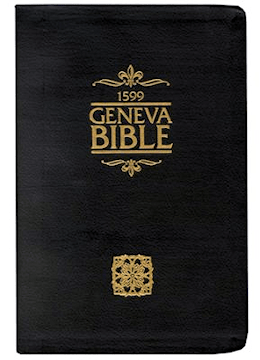Textus Receptus Bibles
Geneva Bible 1560/1599
| 6:1 | In the yeere of the death of King Vzziah, I saw also the Lord sitting vpon an high throne, and lifted vp, and the lower partes thereof filled the Temple. |
| 6:2 | The Seraphims stoode vpon it: euery one had sixe wings: with twaine he couered his face, and with twaine hee couered his feete, and with twaine he did flie. |
| 6:3 | And one cryed to another, and sayde, Holy, holy, holy is the Lord of hostes: the whole world is full of his glory. |
| 6:4 | And the lintles of the doore cheekes moued at the voyce of him that cryed, and the house was filled with smoke. |
| 6:5 | Then I sayd, Wo is me: for I am vndone, because I am a man of polluted lips, and I dwell in the middes of a people of polluted lips: for mine eyes haue seene the King and Lord of hostes. |
| 6:6 | Then flewe one of the Seraphims vnto me with an hote cole in his hand, which he had taken from the altar with the tongs: |
| 6:7 | And he touched my mouth, and sayd, Loe, this hath touched thy lips, and thine iniquitie shall be taken away, and thy sinne shalbe purged. |
| 6:8 | Also I heard the voyce of the Lord, saying, Whome shall I send? and who shall goe for vs? Then I sayd, Here am I, send me. |
| 6:9 | And he sayd, Goe, and say vnto this people, Ye shall heare in deede, but ye shall not vnderstand: ye shall plainely see, and not perceiue. |
| 6:10 | Make the heart of this people fatte, make their eares heauie, and shut their eyes, lest they see with their eyes, and heare with their eares, and vnderstand with their hearts, and conuert, and he heale them. |
| 6:11 | Then sayd I, Lord, howe long? And he answered, Vntill the cities be wasted without inhabitant, and the houses without man, and the land be vtterly desolate, |
| 6:12 | And the Lord haue remoued men farre away, and there be a great desolation in the mids of the land. |
| 6:13 | But yet in it shalbe a tenth, and shall returne, and shalbe eaten vp as an elme or an oke, which haue a substance in them, when they cast their leaues: so the holy seede shall be the substance thereof. |

Geneva Bible 1560/1599
The Geneva Bible is one of the most influential and historically significant translations of the Bible into English, preceding the King James translation by 51 years. It was the primary Bible of 16th century Protestantism and was the Bible used by William Shakespeare, Oliver Cromwell, John Knox, John Donne, and John Bunyan. The language of the Geneva Bible was more forceful and vigorous and because of this, most readers strongly preferred this version at the time.
The Geneva Bible was produced by a group of English scholars who, fleeing from the reign of Queen Mary, had found refuge in Switzerland. During the reign of Queen Mary, no Bibles were printed in England, the English Bible was no longer used in churches and English Bibles already in churches were removed and burned. Mary was determined to return Britain to Roman Catholicism.
The first English Protestant to die during Mary's turbulent reign was John Rogers in 1555, who had been the editor of the Matthews Bible. At this time, hundreds of Protestants left England and headed for Geneva, a city which under the leadership of Calvin, had become the intellectual and spiritual capital of European Protestants.
One of these exiles was William Whittingham, a fellow of Christ Church at Oxford University, who had been a diplomat, a courtier, was much traveled and skilled in many languages including Greek and Hebrew. He eventually succeeded John Knox as the minister of the English congregation in Geneva. Whittingham went on to publish the 1560 Geneva Bible.
This version is significant because, it came with a variety of scriptural study guides and aids, which included verse citations that allow the reader to cross-reference one verse with numerous relevant verses in the rest of the Bible, introductions to each book of the Bible that acted to summarize all of the material that each book would cover, maps, tables, woodcut illustrations, indices, as well as other included features, all of which would eventually lead to the reputation of the Geneva Bible as history's very first study Bible.